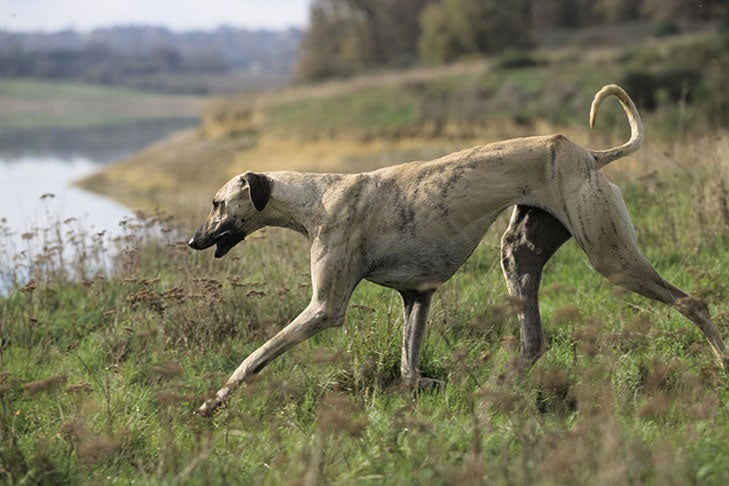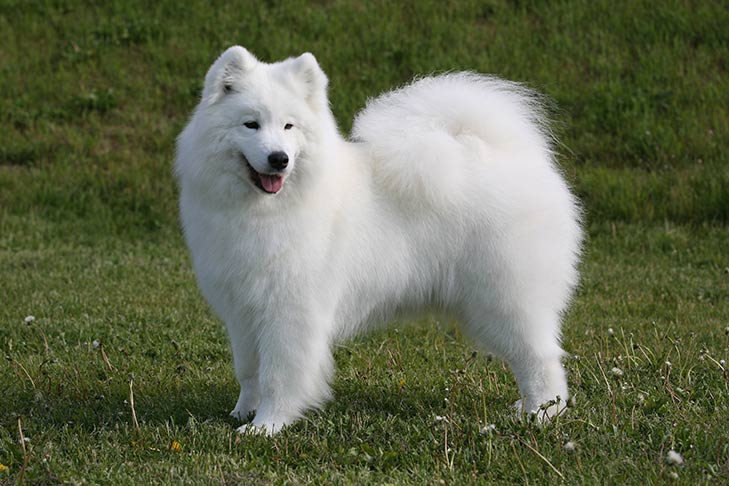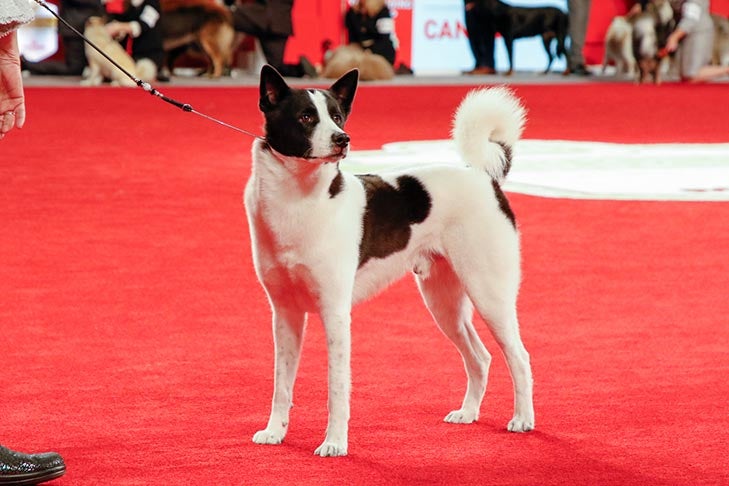
Though the Canaan Dog, the national dog of Israel, was AKC-recognized in 1997, they aren’t a new breed. In fact, a 2500-year-old cemetery in Ashkelon, Israel, contains hundreds of canine skeletons that strongly resemble today’s Canaan Dog: a short-haired, prick-eared, inquisitive animal with a bushy tail that curls over the back.
“The original Canaan Dog could be the descendant of a population of aboriginal dogs that existed with the first people who inhabited Israel and the surrounding areas,” says Janice Koler-Matznick, animal behaviorist, author, and researcher.
The Canaan Dog is considered a primitive dog breed, which refers to its ancient ancestry. The Pug, for example, has roots dating to 400 BC, so what sets primitive dog breeds apart?
What Is a ‘Primitive Dog?’
There are varied terms used to refer to ancient dogs, including “primitive,” “aboriginal,” “village,” and “landrace.” These words have different implications regarding ancestry and evolution. “In biology, primitive means an organism that has not changed since it first appeared, so its ancestral traits are still intact,” explains Koler-Matznick, who specializes in the history of dogs and dingoes. “They’ve been in their current locations, separated from all other dogs, for at least 12,000 years. And they’re the only dogs who live as wild predators, completely independent of humans.”
As a result, what we call “primitive dogs” might be more accurately referred to as “aboriginal.” Koler-Matznick says that they’re also called “village dogs.” “Aboriginal dogs are dogs that have existed in a geographic area from earliest times. These are the traditional village dogs, and in less-industrial areas of the world, they still live today as they have for thousands of years—free-ranging, free-breeding, and raising their puppies on their own among humans.”

Landrace dogs are linked to specific geographic areas and evolved and adapted to their local environments. According to the Primitive and Aboriginal Dog Society, landrace dogs developed characteristics dependent on the climates they lived in, such as double versus single coats.
Differences Between Aboriginal and Purebred Dogs
Aboriginal breeds retain the characteristics of their ancestors and haven’t changed much over long periods of time. “A purebred breed is a population of animals under human control that has been prevented from breeding with dogs outside of the defined breed,” reports Koler-Matznick, a breeder of Rhodesian Ridgebacks for 50 years. “Today, there are several purebred breeds whose ancestors were hand-picked from aboriginal village dogs or old landraces, and while they may retain the general physical and behavioral traits of the source population, they are no longer exactly the same.”
For example, the Samoyed is one of the ancient spitz breeds. The Samoyed adapted to the Siberian cold by developing a lush, weather-resistant double coat. “The original Samoyeds included some that were solid black with a white nose and spotted feet,” according to Koler-Matznick. Today’s AKC breed standard designates proper colors as solid white, white and biscuit, cream, or all biscuit.

Another example Koler-Matznick provides is the Basenji, which she says has maintained a close likeness to the African aboriginal population. Archaeologists believe cave paintings from 6000 BC in Libya depict dogs resembling the Basenji. “In some Basenjis today, the tightly curled tail can’t unfurl. In Africa, the dog’s tail must be able to unfurl so the dog can groom itself to protect from parasites,” she says.
Other aboriginal breeds you may be familiar with include the Sloughi, Ibizan Hound, Portuguese Podengo, Norwegian Lundehund, Shiba Inu, and Xoloitzcuintli. Koler-Matznick explains that many of these breeds still have some common traits, including erect ears, tails curled over their backs, moderate-size muzzles, almond-shaped eyes, and medium size (about 20-35 pounds).
Primitive Breeds in the Modern Age
“Aboriginal dogs still exist in rural areas of Africa, the Middle East, India, Arabia, and Asia,” Koler-Matznick notes. And many aboriginal breeds, like the Canaan Dog, continue to thrive today, largely thanks to passionate breeders like David Golden. Golden, chair of the Canaan Dog Club of America‘s Publicity and Public Education Committee, estimates that there are between 600 and 800 registered Canaan Dogs in the U.S. and about 2000 worldwide.
Golden and Cynthia Dodson got their first Canaan Dog 25 years ago. Named AKC Breeders of Merit, they also own three of the four Canaan Dogs who competed in the 2023 Westminster Kennel Club Dog Show. Golden explains that this ancient breed serves various purposes in the modern world.

“In more recent times, Dr. Rudolphina Menzel recruited 400 of the best dogs to be trained as mine detectors during Israel’s War of Independence and World War II,” says Golden, “and they proved to be more reliable than mechanical detectors. After World War II, Menzel began the peacetime pursuit of breeding and training Canaans as guide dogs for the blind.”
Other aboriginal breeds proved helpful to the people who lived near them. Salukis date as far back as 7000 BC, when they evolved as hunting dogs for royalty. Samoyeds became sled dogs carrying heavy loads across Siberia, providing warmth to the Samoyedic people. The Basenji was one of the early breeds domesticated from aboriginal village dogs that became hunting dogs for the oldest African tribes.
Preservation Breeding and Spreading Awareness
Because primitive and aboriginal breeds are fewer in number than domestic dogs, it is the job of preservation breeders like Golden to grow their numbers and spread their history. “When you are entrusted with a Canaan Dog, you become responsible for actual living history,” says Golden. “This responsibility is multiplied when you are a breeder. You are obligated to not only preserve the embodiment of thousands of years of history but also a breed that is so rare as to be just a few generations from extinction.”
Rural areas where these dogs would primarily make their homes away from civilization are also becoming few and far between. “Aboriginal dogs are highly threatened due to continually progressing human development,” Koler-Matznick says. “European and Asian dogs are becoming more popular in urban and suburban areas.”

Becoming a Primitive Dog Owner
If you’re looking to get a dog, what should you consider if you’re interested in bringing an aboriginal dog into your household? Koler-Matznick notes that aboriginal breeds can often be very self-sufficient and independent. In her experience, positive reinforcement training works best with these dogs. “Patience and understanding are required because, by nature, these dogs are not inclined to cooperate with and obey human desires.”
How does owning an aboriginal breed differ from owning a purebred dog? “Unlike more modern breeds developed by man to perform particular tasks, Canaan Dogs evolved on their own to survive in a hostile environment. That makes them naturally vigilant, which means they can bark a lot,” says Golden. “They can also be reactive—not aggressive—to perceived threats, real or not, which means that early and continuing socialization is important.”
Although Canaan Dogs and many other primitive dog breeds are intelligent and talented generalists capable of engaging in a wide variety of activities, they can also be pretty relaxed. “They don’t need a job. For millennia, their ancestors sheltered from the hot midday sun and cold night, so today’s Canaan Dogs are as happy to relax on the couch as go on a hike or to a day-long agility trial.”

